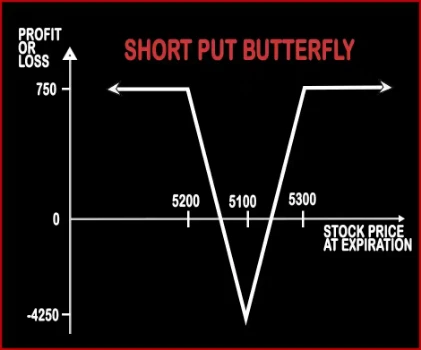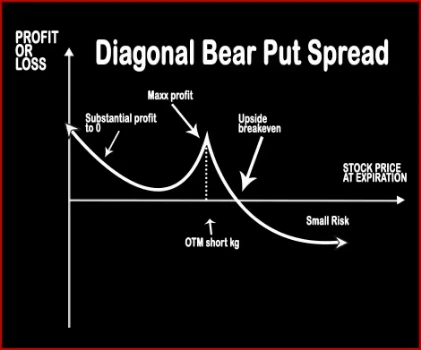Compare Strategies
| SHORT PUT BUTTERFLY | DIAGONAL BEAR PUT SPREAD | |
|---|---|---|

|

|
|
| About Strategy |
Short Put Butterfly Option StrategyIn Short Put Butterfly strategy, a trader is neutral in nature and expects the market to remain range bound in the near future. A trader will buy 2 ATM Put Options; sell 1 ITM & 1 OTM Put Options. Here risk and returns both are limited. Risk:< |
Diagonal Bear Put SpreadWhen the trader is neutral – bearish in the near-month and bearish in the mid-month, he will apply Diagonal Bear Put Spread. This strategy involves buying Mid-Month ITM Put Options and selling (short/write) equal number of Near-Month OTM Put Options, of the same underlying asset. This strategy bags limited rewards with limited risk. |
SHORT PUT BUTTERFLY Vs DIAGONAL BEAR PUT SPREAD - Details
| SHORT PUT BUTTERFLY | DIAGONAL BEAR PUT SPREAD | |
|---|---|---|
| Market View | Neutral | Bearish |
| Type (CE/PE) | PE (Put Option) | PE (Put Option) |
| Number Of Positions | 4 | 2 |
| Strategy Level | Advance | Beginners |
| Reward Profile | Limited | Limited |
| Risk Profile | Limited | Limited |
| Breakeven Point | Upper Breakeven Point = Strike Price of Highest Strike Short Put - Net Premium Received, Lower Breakeven Point = Strike Price of Lowest Strike Short Put + Net Premium Received | This is a dynamic trade with many possible scenarios and future trades, it is impossible to calculate a breakeven. |
SHORT PUT BUTTERFLY Vs DIAGONAL BEAR PUT SPREAD - When & How to use ?
| SHORT PUT BUTTERFLY | DIAGONAL BEAR PUT SPREAD | |
|---|---|---|
| Market View | Neutral | Bearish |
| When to use? | In Short Put Butterfly strategy, a trader is neutral in nature and expects the market to remain range bound in the near future. | When the trader is neutral – bearish in the near-month and bearish in the mid-month, he will apply Diagonal Bear Put Spread. This strategy involves buying Mid-Month ITM Put Options and selling (short/write) equal number of Near-Month OTM Put Options, of the same underlying asset |
| Action | Sell 1 ITM Put, Buy 2 ATM Put, Sell 1 OTM Put | Sell 1 Near-Month OTM Put Option, Buy 1 Mid-Month ITM Put Option |
| Breakeven Point | Upper Breakeven Point = Strike Price of Highest Strike Short Put - Net Premium Received, Lower Breakeven Point = Strike Price of Lowest Strike Short Put + Net Premium Received | This is a dynamic trade with many possible scenarios and future trades, it is impossible to calculate a breakeven. |
SHORT PUT BUTTERFLY Vs DIAGONAL BEAR PUT SPREAD - Risk & Reward
| SHORT PUT BUTTERFLY | DIAGONAL BEAR PUT SPREAD | |
|---|---|---|
| Maximum Profit Scenario | Net Premium Received - Commissions Paid | 'Premiums received - Initial premium to execute + Strike price - Stock Price on final month |
| Maximum Loss Scenario | Strike Price of Higher Strike Short Put - Strike Price of Long Put - Net Premium Received + Commissions Paid | When the stock trades up above the long-term put strike price. |
| Risk | Limited | Limited |
| Reward | Limited | Limited |
SHORT PUT BUTTERFLY Vs DIAGONAL BEAR PUT SPREAD - Strategy Pros & Cons
| SHORT PUT BUTTERFLY | DIAGONAL BEAR PUT SPREAD | |
|---|---|---|
| Similar Strategies | Short Condor, Reverse Iron Condor | Bear Put Spread and Bear Call Spread |
| Disadvantage | • High risk strategy and may cause huge losses if the price of the underlying stocks falls steeply. • Higher profit is only possible when shares get close to expiration. | Higher commissions due to additional trades. , Changes maximum profit potential of call or put spreads. |
| Advantages | • Benefits from time decay. • Traders can earn more in a rising or range bound scenario. • Benefits from a surge in volatility. | The Risk is limited. |